Beaters, Combs and all such things-I hope!-eventually!
Beaters and combs and grattoirs/ scrappers.

FIRST Two Caveats
1. There is no right or wrong tool, if it works for your chosen purpose. THERE ARE NO TAPESTRY POLICE! No one is going to take your tools away from you, if you choose to use them in an odd or different way then someone else! The tool is right if it works for you. But, perhaps curiosity about tools, how, and why they work is a good thing. Perhaps, there might be a more efficient tool or perhaps you didn’t know there were choices. So for whatever reason- this blog is

about having more choices and knowing why those choices might be good or bad or maybe something might work better.
2. Most of the information in this blog is based on my research, curiosity and tapestry journals that I have kept since 1978. Please fill free to add or make comments or state an opinion about a tool! It would be great if this Tapestry Compendium post would engender a great deal of comment and discussion.
So here Goes and/ or !!Finding a beginning place!!
First things first–What can and or do these tools influence in tapestry weaving ? Beaters, combs and grattoirs can easily influence the density, loft, and/or hand of the fabric, if the weft covers the warp or if the fell line collapses into a valley or rises in places, and the grain of the fabric-especially with continuous warping patterns.
The wrong beat can collapse a tapestry and skid it around the warps if precautions aren’t taken…and, or used correctly. Tapestry wefts can fairly easily be moved up and down warps if beaten to heavily or not enough. But, depending on weaving tradition, weaving materials, warp setting, weft bundle size… you may not wish to beat, but comb the wefts into place. There is a big difference between combing and beating.
There are also beating and combing problems that need to be addressed in using the smaller looms. Such as stabilizing the fell line and warp in some way, especially when using continuous warping methods.
There are two possible solutions such as have the bottom selvedge resting on something that won’t move a dowel or a wire.
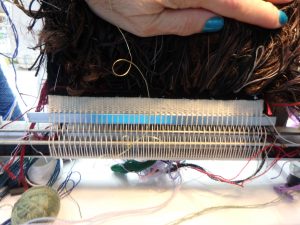
Flat metal rod and metal rods woven in before weaving begins.
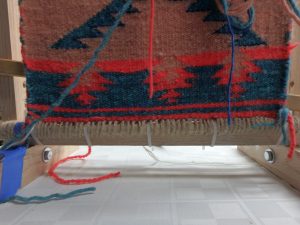
Navajo style weaving twined and then wrapped to a dowel.
(Yes! there are other things that can also influence anyone of these factors, but it doesn’t hurt to include this in the major possibilities when considering a problem in tapestry beating and combing) And, of course, beating and combing techniques can influence how much tension needs to be on a loom/ warp and the stability of the warp/ and or fell line. .
DEFINITIONS
Pictures by categories are always more enlightening to me and I hope others. So the next section is based on traditional uses of these tools and the type of looms they were often used on. I can’t say it often enough that information on tradition and whys is being lost. And, perhaps the information was more insider info and oral tradition. I have been collecting these tools since 1978. Much of the information is anecdotal and can always stand some editing and more…
I would love to have more information and pictures to include in the following commentary. Anyone that sends information will be credited.
Traditionally, Beaters, combs, and grattoirs/scrappers are tapestry tools used for packing in weft and placing weft along the fell of a tapestry while the tapestry is under tension from the loom or in some cases pressure from the back or feet. These are the ways that I would define-Please fill free to add your definitions or usages to the discussion. I use the word traditionally, because in the last 30 years or so definition’s and usage have blurred thanks to the internet, lack of information about the tools being disseminated and acculturation or blending of tapestry information among the different traditions of tapestry weaving.
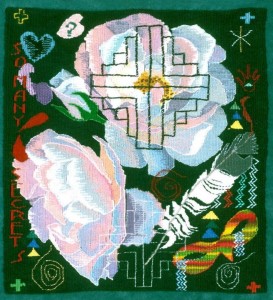
Gramma’s Secret; wool; 10 epi
Beaters are usually meant to strike the fell line really hard. Often the harder the better. So the heavier the beater can or may be, to make it easier physically. The harder the beat the denser the hand of the fabric. The weight of the beat helps to remove the loft or air from the wool and the weft of other weaving materials and pack the weft down very tightly. The hand of the fabric can be very dense, very stiff and not very wearable or drape-able-especially in small format tapestries. Often the beaters are heavier, metal, and or weighted to aid in packing the weft materials down. Often the bottom of the teeth are flat or slightly hooked down to give a more solid beat. With these particular shapes of beaters and upright looms at 90 degrees or perpendicular to the ground the beater will hit solidly and not skitter down the face of the tapestry that a comb with a curved tooth might allow. Many of the older looms and also newer looms are often built with a 5 decree slant that allows for a more direct strike of the beater enabling the beater to strike more solidly against the fell line.
High warp-Gobelin style, Gobelin Style looms, Scandinavian Gobelin style weaving as opposed to Åklae and Rölaken which are done floor looms) many middle eastern looms. The warps generally run vertically at a 90degree angle or with a 5% tilt-give or take., Mirrix looms, Shannock looms, Copper looms, and many tapestry looms sold through many companies.
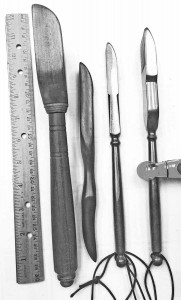
Side view- of high warp beaters -note the flat horizontal bottoms of the teeth. The Shannock beater design were heavily influenced in their design by Savonnerie rug beaters.
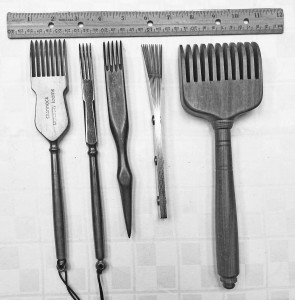
Hi warp beaters, All flat bottomed teeth
Large and small Shannock beater, Wooden Shannock beater designed for me by John Shannock for beating small scale/small format tapestry, Persian beater, Swedish Hi-warp. beater.
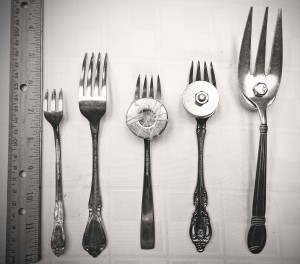
Variations of fork beaters, traditionally used in Scandinavia without weights on up right looms. I adapted weights to them about 30 years ago for added weight when beating. Eventually, the fork beater evolved into a series of removable weights with a nut and bolt.
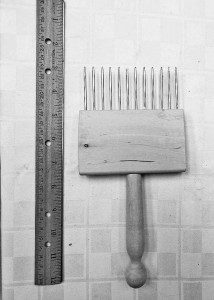
Pin style beater, should actually be labeled as a comb. Not meant for beating, but combing. Pins have a tendency to break or eventually split the wood, because of the direction of the grain of the wood, if used for beating over time.
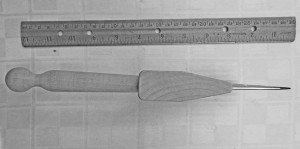
side view of a pin style beater or comb-note the wood grain is directional and cause problems if used as a beater. These come in many variations and work well when used as a comb.
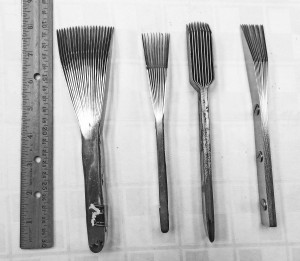
Persian metal Beaters in various sizes used for tapestry and rugs.

Side view of Persian beaters. Note the flat teeth. I have redesigned the small beater on the far right so that it has no fire scale or rust using stainless steel and a different less snag able rivet for Between & Etc.
|
A. Navajo looms are an upright exception and most often use combs(see combs) because of the softer placement of the weft, slightly less tension on the warp and the comb is used to place the weft, but for setting weft tension. The batten packs the weft not the comb. (Thank you for the info Roy Kady Gonna Bitsóó and Zefren VJ zef Hunt-Anderson.) Russian or Turkish “Old Belivers” weave tapestry belts on a type of back strap loom that uses the back side of a large knife as a beater. Scandinavian weavers often use dinner forks as tapestry beaters on both low and high warp looms depending on whether they are weaving Gobelin style, åklae or Rölaken or low warp looms. |
Basse Lisse or low warp beaters.
Basse lisse beaters are tools not part of the loom that were specifically designed for low warp tapestry.(example: Aubusson looms) The warp is almost parallel a to the floor. Many basse lisse looms have a slight tilt to aid in beating. They are not what most perceive as a traditional floor loom. There are many traditions with the warp running parallel to the floor-SW style looms, Walking Looms, Countermarche Looms, Jack looms (even though the jack looms are difficult to get a good shed if the tension is tight enough-best used without using the jacks or jacked sheds) Aubusson looms do not usually have an attached beater, but are beaten with an Aubusson style beater and or a rug style beater. In many traditions the low warp looms use a built in beater that beats completely across the fell line to beat the weft into place and do not build up in any one area. A beater or comb is only used to beat in small areas to even out the fell line when it is filled in. (Thanks Lisa Trujillo).
Basse Lisse generally does not have an attached beater and can build up in different areas across the fell line in basically the same way a high warp loom builds up shapes. Most if not all beaters for basse lisse were designed as beaters for this particular style of loom and a very particular style of beating. The beater is held between the thumb and fingers-sometimes held by both hands and flicked back against the fell line. They do have curved teeth that are have been adapted to the way they are flicked against the fell line where a curved tooth is desirable as it flicks backward and slightly upwardly and
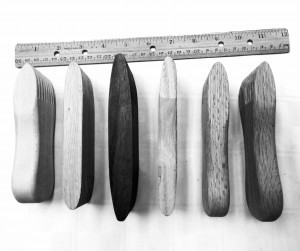
Side view of Aubusson beaters. Yes, they have curved teeth to add in the process of beating towards the fell line.
hard against the file line-not as a comb. They generally are not used to place the weft, but to beat it in. Wefts are placed by using bones or a special bobbin and a grattoirs or scraper.
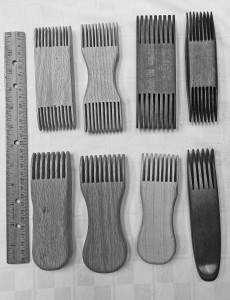
Aubusson or low warp style beaters from the top. They can be double ended or single ended. The ones with the waist I designed to make it easier to hang onto while beating. The left one on the second row was traded to me in exchange for one of my waisted beaters in the 80’s by a Aubusson weaver who liked to design tools and is not traditional, but her variation.
Grattoirs and or scrappers
Grattoirs and or scrappers are generally smaller in size-palm size and are used for bringing the weft bubble down placing the weft along the fell line they are not used for beating or combing large areas of weft into its final resting place.
My first awareness of grattoirs was when I was researching Aubusson low warp weaving. They can be made of almost any substance. They were not originally used on high-warp looms, but in the last 20 years have been adapted into high warp weaving for bringing the bubble into place. They are especially handy when using silks, embroidery floss or mixtures of finer and thicker wefts. But, there seems to be a whole category of scrapers that have been adapted from many different places to be used as both scrappers and combs. Originally not meant to be used as beaters or combs.
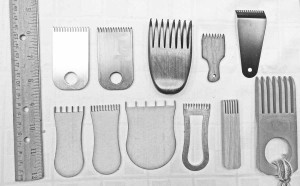
Variations of grattoirs or scrappers. The bottom ones are all ones that I designed and sale through Between & Etc. The small wooden one and it’s larger twin are wood. All fit in the palm of the hand and even traditional ones are usually about 3 inches by 3 inches. Traditionally they were made of wood and I have seen ivory ones.
COMBS
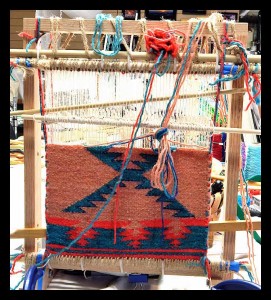
My first attempt at Navajo Style weaving with Roy Gonna Bitso’o’ Kady
Combs are used just as implied by their name to comb the weft into place along the fell line much more gently and not really beaten. In Navajo style weaving a batten is used to place the warp against the fell line. A comb gently combs or taps the weft into place rather gently as compared to beaten tapestries-European and Middle Eastern tapestries. Often the tooth curves to a point. Historically Navajo beaters were much thinner .25 -.5(give or take a bit) and the tapered tooth was very gradual taper from the beginning of the tooth to the end of the tooth or point. Mostly combs are carved from wood and not made of metal. Often times the relationships between warps and
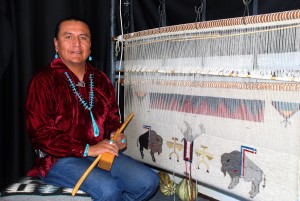
Roy Gonna Bitso’ Kady with traditional weaving tools and upright loom.
wefts vary from those using beaters- a little further part for the amount of wool used in the weft bundle. When using combs traditionally relationships between warp and weft and sometimes warp spacing differs then in European and middle eastern weaving. With perhaps in SW weaving there is a greater spacing between warps and the wefts may also be thinner in relationship to the weft or use singles in the weft bundle in stead of multiple threads or yarns in the weft bundle when using combs.
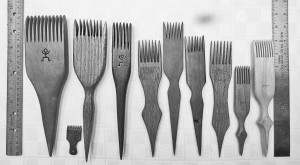
More or less traditional Navajo beaters. Third one from the right was crafted in a traditional style-The tiny one-second on the right was a gift for using with my small format/small scale weaving. There are many variations and shifts in style in traditional shapes and protecting the hands from Carpal tunnel according to Zefren. Mixed with combs purchased from Al Snipes and Naja.
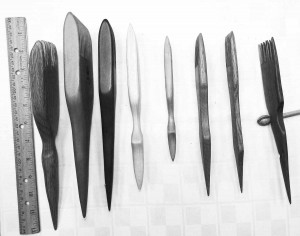
Side view of Navajo combs.
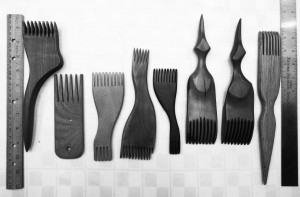
Variations of Combs-Traditional and not so traditional. the first and the last 3 were designed by Al Snipes. Second from the right was purchased from a Peruvian indigenous tapestry weaver. 3 -5 were purchased from African Saharan tribal weavers and I have lost the name of the tribe over time-the early 80’s.
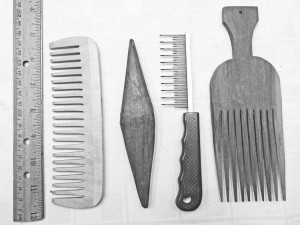
Variations of combs that I have seen used in the past. They include a wooden comb, A very old traditional Bulgarian tapestry pick used for combing given to me by a friend used for combing and placing weft, dog combs, hair comb and a Traditional African tribal African hair comb.
Body Parts as tapestry beaters, combs and scrappers
When I was asking on for information on FaceBook and the tapestry2005 yahoo list. Many weavers thought that I should include body parts such as fingers used for placing the wefts into position.
My favourite body part to use is my finger nails to place the wefts. When I first began to weave tapestry I was told never top use my fingernails, because I could pull my nails loose from the beds. In European tapestry we are often warned not to use are fingernails to place or scrape weft into place. I discovered that it all depends on how you do it. If the nails are pointed down and parallel to the weft it doesn’t damage the nail beds. If done with the nails at right angles it can lift the nails from the nail beds and damage the nails. What I have since discovered is if but your nails against the warps and beat straight down it doesn’t damage the nails. Beating with the nails only damages the nails if they are at a 90 degree angle to the warp when you pull or beat down. The main hazard is that the tight warps can skin up the surface of the skin above the nails.
Using various parts of the hands came up as being used as beaters, combs, scrappers and grattoirs from South American weavers and Asian weavers especially the pinching of the thumb and first finger to pull the wefts into place.
In some forms of Japanese tapestry the fingernails are used to place and beat weft. The fingernails are “pinked”-cut into mountains and valleys.
It has also been pointed out to me that many traditional weavers use their fingers to place and move the weft into place along the fell line. It can also be called thwacking a term popularized by Archie Brennen and discouraged in Europe and North America.
Floor loom weaving example(not to be confused with
Aubusson and other Basse Lisse looms)
In Floor loom weaving the beater is used to place the wefts into place. The floor loom beater places or beats in the weft one shed at a time. The weaving does not built up in any given area. The beater will not work correctly when the fell line is higher or lower in places. According to Liza Trujillo of Centinela combs are occasionally used to place weft in low spots or to build up in small areas. Basse Lisse weaving(an example-Aubusson style looms) is generally not done with a built in beater.
Nice